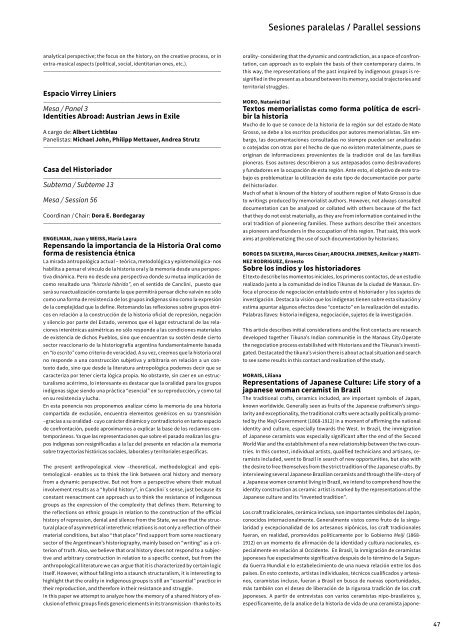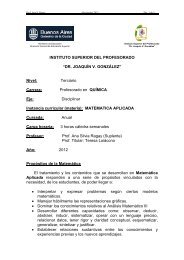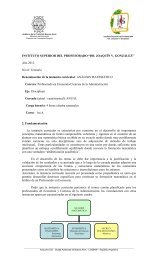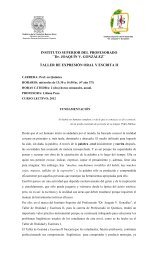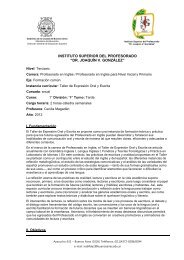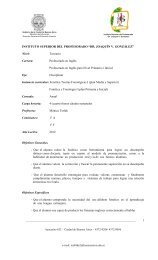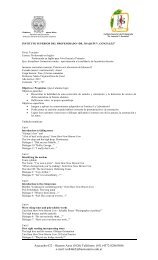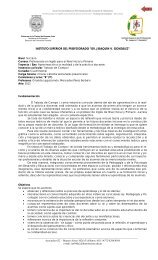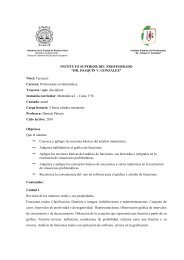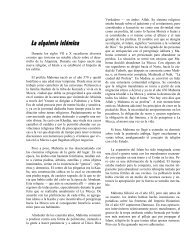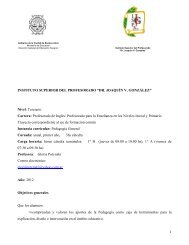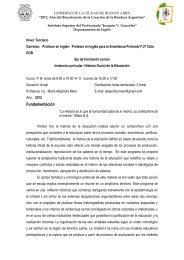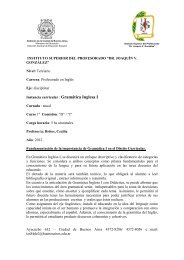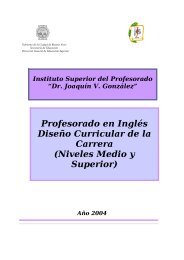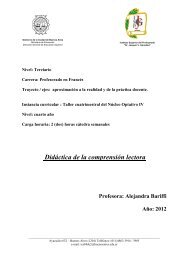Sesiones parale<strong>la</strong>s / Parall<strong>el</strong> sessionstroupe’s arrest, who’s lived in a communal way in the city for three months,caused a great repercussion, inclusiv<strong>el</strong>y an international campaign for theirfreedom, <strong>en</strong>closed with their expulsion of the country. This fact was one of themilitary repression marks of the artistic and theatral c<strong>la</strong>ss, and specially of thecontraculture. The purpose of this work is to analyse the memory of the LivingTheatre passage through Ouro Preto. On the one hand, if libertine repres<strong>en</strong>tationsof artists’ lives and drugs use were caricatural remarkable on the pressof that time, on the other hand, the memories of esthetics innovations whichwere proposed by the group, their humanity and work with childr<strong>en</strong> from aworkm<strong>en</strong> quarter were <strong>en</strong>graved into people’s minds. The register and studyof these memories h<strong>el</strong>p us to un<strong>de</strong>rstand better the t<strong>en</strong>sions and impacts thatthe called contraculture everyday practices provoked in a conservative <strong>en</strong>vironm<strong>en</strong>tsuch as Ouro Preto, in a totally military dictatorship, as w<strong>el</strong>l as theapproximation betwe<strong>en</strong> part of the youth and local artists, p<strong>la</strong>cing them asicons of dictatorship and conservativ<strong>en</strong>ess rejection.El Estado autoritario brasileño, bajo <strong>el</strong> régim<strong>en</strong> militar (1964-1984), reprimió ypersiguió no sólo a <strong>la</strong>s izquierdas (comunistas, socialistas, etc), sino también<strong>la</strong>s manifestaciones sociales, estéticas y políticas <strong>de</strong> <strong>la</strong> l<strong>la</strong>mada contracultura,vista <strong>en</strong> <strong>el</strong> imaginario <strong>de</strong> <strong>la</strong> extrema <strong>de</strong>recha como un “comunismo invisible”con <strong>la</strong> misión <strong>de</strong> <strong>de</strong>struir <strong>la</strong> familia y <strong>la</strong> tradición cristiana, lo que permitiría <strong>el</strong>surgimi<strong>en</strong>to <strong>de</strong> un régim<strong>en</strong> moscovita. En este contexto, <strong>en</strong> 1971, ocurrió <strong>la</strong> prisión<strong>de</strong> los miembros <strong>de</strong>l conceptuado grupo Living Theatre, los pioneros <strong>de</strong>lteatro off-Broadway, cuando se preparaban para participar <strong>de</strong>l Festival <strong>de</strong> Invierno<strong>de</strong> Ouro Preto, <strong>en</strong> <strong>la</strong> provincia <strong>de</strong> Minas Gerais. La <strong>de</strong>t<strong>en</strong>ción <strong>de</strong> <strong>la</strong> compañía,que vivía <strong>de</strong> forma comunal <strong>en</strong> <strong>la</strong> ciudad minera t<strong>en</strong>ía tres meses, causógran repercusión, incluy<strong>en</strong>do una campaña internacional para su liberación,que terminó con su expulsión <strong>de</strong>l país. Este hecho fue un marco <strong>en</strong> <strong>la</strong> represión<strong>de</strong> los militares a <strong>la</strong> c<strong>la</strong>se artística y teatral y <strong>en</strong> particu<strong>la</strong>r a <strong>la</strong> contracultura.El objetivo <strong>de</strong> esta investigación es analizar <strong>la</strong>s memorias <strong>de</strong> los resi<strong>de</strong>ntes <strong>de</strong>Ouro Preto sobre <strong>el</strong> paso <strong>de</strong>l Living Theatre por <strong>la</strong> ciudad y <strong>la</strong>s repres<strong>en</strong>tacionesque figuran <strong>en</strong> él. Si, por un <strong>la</strong>do, son recurr<strong>en</strong>tes <strong>la</strong>s repres<strong>en</strong>taciones, <strong>de</strong>forma caricatural, <strong>de</strong> una vida libertina <strong>de</strong> los artistas y <strong>el</strong> uso <strong>de</strong> drogas, por<strong>el</strong> otro, se registran, junto con estos, los recuerdos <strong>de</strong>l humanismo <strong>de</strong>l grupo y<strong>el</strong> trabajo que realizó con los niños <strong>de</strong> un barrio <strong>de</strong> c<strong>la</strong>se obrera. El registro y <strong>la</strong>análisis <strong>de</strong> estos recuerdos nos ayudan a compr<strong>en</strong><strong>de</strong>r mejor <strong>la</strong>s t<strong>en</strong>siones y loschoques que <strong>la</strong>s prácticas cotidianas <strong>de</strong> <strong>la</strong> l<strong>la</strong>mada contracultura provocaban<strong>en</strong> un ambi<strong>en</strong>te conservador como Ouro Preto, <strong>en</strong> pl<strong>en</strong>a dictadura militar, y <strong>la</strong>aproximación <strong>de</strong> parte <strong>de</strong> los jóv<strong>en</strong>es y artistas locales a <strong>el</strong> grupo, poni<strong>en</strong>do <strong>el</strong>Living Theatre como icono <strong>de</strong>l rechazo a <strong>la</strong> dictadura y a <strong>el</strong> conservadurismo.BRANCHER, AnaLa literatura y <strong>la</strong> resist<strong>en</strong>cia. Cinco escritoras <strong>de</strong>l ConoSurEn difer<strong>en</strong>tes mom<strong>en</strong>tos <strong>de</strong> <strong>la</strong> <strong>historia</strong>, <strong>la</strong>s escritoras <strong>la</strong>tinoamericanas, o porlo m<strong>en</strong>os algunas <strong>de</strong> <strong>el</strong><strong>la</strong>s, han <strong>de</strong>mostrado un <strong>de</strong>sempeño eficaz <strong>en</strong> los esc<strong>en</strong>arios<strong>de</strong> <strong>la</strong> política adoptada por sus gobiernos, ya sea <strong>en</strong> <strong>la</strong> actividad literaria<strong>en</strong> sí mismo (es <strong>de</strong>cir, <strong>la</strong> publicación <strong>de</strong> <strong>la</strong>s nove<strong>la</strong>s), ya sea cubrir puestos públicoscomo diputadas, asesoras, diplomáticas, profesoras, como articu<strong>la</strong>doras<strong>de</strong> <strong>la</strong>s marchas, confer<strong>en</strong>cias, manifiestos, revistas, asociaciones.La pres<strong>en</strong>te Comunicación examina <strong>el</strong> diálogo <strong>en</strong>tre <strong>el</strong> campo literario y político,t<strong>en</strong>i<strong>en</strong>do como trazado <strong>de</strong> recorte cinco escritoras <strong>de</strong>l Cono Sur, sus trabajosescritos o publicados durante <strong>la</strong>s dictaduras o que ti<strong>en</strong><strong>en</strong> <strong>el</strong> período comotema, así como su pap<strong>el</strong> <strong>en</strong> <strong>el</strong> proceso <strong>de</strong> <strong>la</strong> <strong>de</strong>mocratización <strong>de</strong> sus países. Lasdictaduras civiles y militares que se han as<strong>en</strong>tado <strong>en</strong> <strong>el</strong> Cono Sur <strong>en</strong>tre 1950y 1990, aproximadam<strong>en</strong>te, interrumpieran los procesos <strong>de</strong> mo<strong>de</strong>rnizacióny <strong>de</strong>mocratización <strong>de</strong> <strong>la</strong> región. Una <strong>de</strong> <strong>la</strong>s primeras medidas adoptadas porlos gobiernos dictatoriales fue “sil<strong>en</strong>ciar” a <strong>la</strong> g<strong>en</strong>te que estaba <strong>en</strong> contra losnuevos esquemas, lo que significó <strong>la</strong> <strong>el</strong>iminación <strong>de</strong> los proyectos políticos <strong>de</strong>g<strong>en</strong>eraciones <strong>en</strong>teras <strong>de</strong> difer<strong>en</strong>tes categorías y c<strong>la</strong>ses sociales. Miles <strong>de</strong> obreros,campesinos, maestros, estudiantes, artistas, políticos fueron arrestados,torturados, exiliados, asesinados. La c<strong>en</strong>sura <strong>de</strong> <strong>la</strong>s obras <strong>de</strong> arte y los artistasera una práctica habitual. Al mismo tiempo que se insta<strong>la</strong>ba <strong>en</strong> estas prácticasrepresivas, <strong>el</strong> terrorismo <strong>de</strong> Estado llevó a <strong>la</strong> resist<strong>en</strong>cia <strong>de</strong> estas categorías.En <strong>el</strong> contexto <strong>de</strong>scrito, <strong>la</strong>s discusiones teóricas y <strong>en</strong>foques metodológicosalim<strong>en</strong>tados por <strong>el</strong> canal <strong>de</strong> <strong>la</strong> <strong>historia</strong> <strong>oral</strong> permit<strong>en</strong> una interpretación <strong>de</strong> <strong>la</strong><strong>historia</strong> reci<strong>en</strong>te, <strong>la</strong>s <strong>de</strong>fici<strong>en</strong>cias todavía <strong>en</strong>ormes <strong>en</strong> <strong>la</strong> historiografía <strong>de</strong> AméricaLatina.CRISTERNA SÁNCHEZ, ArturoHistoria <strong>de</strong> vida <strong>de</strong> <strong>la</strong> artista plástica Nina Mor<strong>en</strong>oLa ciudad <strong>de</strong> Tijuana, México, ha sido objeto <strong>de</strong> innumerables estudios sociológicos<strong>de</strong>bido a los f<strong>en</strong>óm<strong>en</strong>os sociales que <strong>en</strong> esta ciudad se han v<strong>en</strong>ido <strong>de</strong>sarrol<strong>la</strong>ndo<strong>en</strong> <strong>la</strong>s últimas décadas, sobre todo <strong>en</strong> lo que respecta a migración.Dichos estudios han sido muy ricos <strong>en</strong> lo que concierne a f<strong>en</strong>óm<strong>en</strong>os migratorios<strong>en</strong> <strong>el</strong> que intervi<strong>en</strong><strong>en</strong> migrantes <strong>de</strong> escasos recursos, muchos <strong>de</strong> los cualesvi<strong>en</strong><strong>en</strong> a Tijuana con <strong>el</strong> propósito <strong>de</strong> cruzar <strong>la</strong> frontera política <strong>en</strong>tre México yEstados Unidos.Sin embargo, exist<strong>en</strong> otros actores sociales cuya <strong>historia</strong> reve<strong>la</strong> otro tipo <strong>de</strong>migración, y cuyo estudio expone i<strong>de</strong>ntida<strong>de</strong>s distintas <strong>de</strong> aqu<strong>el</strong>los grupos, ei<strong>de</strong>as difer<strong>en</strong>tes sobre su lugar <strong>de</strong> orig<strong>en</strong> y sobre Tijuana. Tal es <strong>el</strong> caso <strong>de</strong> <strong>la</strong> artistaplástica Nina Mor<strong>en</strong>o Pastrana, cuya <strong>historia</strong> a continuación se cu<strong>en</strong>ta através <strong>de</strong> su propio testimonio y <strong>de</strong> <strong>la</strong> <strong>historia</strong> <strong>de</strong> ciertos lugares que influyeron<strong>en</strong> su vida privada y <strong>en</strong> su trayectoria artística.The bor<strong>de</strong>r city of Tijuana, Mexico, has be<strong>en</strong> the focus of many sociologic studies,due to the social ph<strong>en</strong>om<strong>en</strong>a that has be<strong>en</strong> <strong>de</strong>v<strong>el</strong>oping in the city throughoutthe <strong>la</strong>st <strong>de</strong>ca<strong>de</strong>s, being migration the main subject in almost all of them.Said studies have be<strong>en</strong> very successful in illustrating migration ph<strong>en</strong>om<strong>en</strong>ain which poor migrants interv<strong>en</strong>e, many of whom come to Tijuana in hopes ofcrossing the barrier that divi<strong>de</strong>s Mexico from the United States.Neverth<strong>el</strong>ess, there are other social actors who’s lives reveal other forms ofmigration that wh<strong>en</strong> studied exposes another kind of i<strong>de</strong>ntity and differ<strong>en</strong>ti<strong>de</strong>as about Tijuana and the p<strong>la</strong>ce they left behind. That is the case of visua<strong>la</strong>rtist Nina Mor<strong>en</strong>o Pastrana, whose history is told in this paper through hisown testimony and the history of the p<strong>la</strong>ces that have influ<strong>en</strong>ced her privat<strong>el</strong>ife and her artistic career.BATISTA, Juliana W<strong>en</strong>dpapMúsica e <strong>historia</strong> <strong>en</strong> <strong>la</strong>s canciones <strong>de</strong>l LP “C<strong>la</strong>ra Crocodilo”<strong>de</strong> Arrigo Barnabé: análisis <strong>de</strong>l contexto socialy cultural <strong>en</strong> los años 1970 y 1980The composer from Paraná Arrigo Barnabé is consi<strong>de</strong>red one of the mainrepres<strong>en</strong>tatives of Paulistana Vanguard. This was an act time that becameknown in the 1980s for the aesthetic stance of r<strong>en</strong>ewing its musicians. ArrigoBarnabé received att<strong>en</strong>tion to have be<strong>en</strong> appointed as the first composer touse the techniques of serial music in the production of popu<strong>la</strong>r music. In 1980,the r<strong>el</strong>ease of his LP C<strong>la</strong>ra Crocodilo had a powerful impact on the urban <strong>la</strong>ndscapeof brazilian popu<strong>la</strong>r music. The fact offered praise and led him for beingconsi<strong>de</strong>red by the press as the great new post-tropicalia. For the production ofC<strong>la</strong>ra Crocodilo, Arrigo Barnabé used wi<strong>de</strong>ly serial music, and characters of hissongs, thematizing the adv<strong>en</strong>tures of an office boy transformed into a hybridmonster, were inspired by comic books. Therefore, the proposal for this communicationis to establish a dialogue betwe<strong>en</strong> music and history, specificallythe re<strong>la</strong>tionship betwe<strong>en</strong> the work of the composer Arrigo Barnabé and culturalprocess and social policy that are re<strong>la</strong>ted on it. In this s<strong>en</strong>se we int<strong>en</strong>d,through an analysis of <strong>oral</strong> narrative and the recurr<strong>en</strong>ce of the composer in hisspeech, evaluate the positioning of the front of the same artistic possibilitiesof action living in the system of military civilian dictatorship in Brazil, consi<strong>de</strong>ringthat the eight songs of C<strong>la</strong>ra Crocodilo were composed betwe<strong>en</strong> 1972and 1980. The sources to be used inclu<strong>de</strong> newspaper clippings and magazines,the Lp in question, and an <strong>oral</strong> interview conducted with Arrigo Barnabé. Thisresearch is part of the study that is being <strong>de</strong>v<strong>el</strong>oped from the project “SerialMusic and Popu<strong>la</strong>r Music - Arrigo Barnabé in the context of the 1970 and 1980:History and Art pres<strong>en</strong>t in the social perception of the composer through of theC<strong>la</strong>ra Crocodilo LP” in the master program in History of PUCRS.Santhiago, RicardoOral history and the arts: A review of the BrazilianliteratureAfter carrying out a number of research using <strong>oral</strong> narratives in the study ofBrazilian art history, focusing particu<strong>la</strong>rly Brazilian popu<strong>la</strong>r music, I have be<strong>en</strong><strong>de</strong>v<strong>el</strong>oping a project on the history of <strong>oral</strong> history in Brazil, from the perspectiveof int<strong>el</strong>lectual history. In this paper, I put both themes together, performinga survey and a critical analysis of Brazilian scho<strong>la</strong>rly work, in the fi<strong>el</strong>d of <strong>oral</strong>history, on the memory of artists, cultural movem<strong>en</strong>ts and creative practices.As we know, <strong>oral</strong> histories have be<strong>en</strong> wi<strong>de</strong>ly used in this sort of studies. In thisliterature review, I will consi<strong>de</strong>r works on: 1. Artists and collectives of artistsin their differ<strong>en</strong>t fi<strong>el</strong>ds: music, literature, visual arts, dance, circus, digital art,cinema, theater; 2. Artistic movem<strong>en</strong>ts and their mom<strong>en</strong>ts; 3. Cultural expressions,in a broad range of analytical frameworks (popu<strong>la</strong>r culture, high culture,mass culture, etc.); 4. Systematic use of <strong>oral</strong> accounts on research on creativeprocess, connected with other tools such as the so-called “g<strong>en</strong>etic criticism”.This collection of works will be analyzed according to: the methodologicalperspective used in gathering and interpreting <strong>oral</strong> sources; topics and periodscovered; theoretical positions governing the choice of subject and the46
Sesiones parale<strong>la</strong>s / Parall<strong>el</strong> sessionsanalytical perspective; the focus on the history, on the creative process, or inextra-musical aspects (political, social, i<strong>de</strong>ntitarian ones, etc.).——————————————————————————————————————————————Espacio Virrey Liniers——————————————————————————————————————————————Mesa / Pan<strong>el</strong> 3I<strong>de</strong>ntities Abroad: Austrian Jews in ExileA cargo <strong>de</strong>: Albert Lichtb<strong>la</strong>uPan<strong>el</strong>istas: Micha<strong>el</strong> John, Philipp Mettauer, Andrea Strutz——————————————————————————————————————————————Casa <strong>de</strong>l Historiador——————————————————————————————————————————————Subtema / Subteme 13Mesa / Session 56Coordinan / Chair: Dora E. Bor<strong>de</strong>garay——————————————————————————————————————————————ENGELMAN, Juan y WEISS, María LauraRep<strong>en</strong>sando <strong>la</strong> importancia <strong>de</strong> <strong>la</strong> Historia Oral comoforma <strong>de</strong> resist<strong>en</strong>cia étnicaLa mirada antropológica actual – teórica, metodológica y epistemológica- noshabilita a p<strong>en</strong>sar <strong>el</strong> vínculo <strong>de</strong> <strong>la</strong> <strong>historia</strong> <strong>oral</strong> y <strong>la</strong> memoria <strong>de</strong>s<strong>de</strong> una perspectivadinámica. Pero no <strong>de</strong>s<strong>de</strong> una perspectiva don<strong>de</strong> su mutua implicación <strong>de</strong>como resultado una “<strong>historia</strong> híbrida”, <strong>en</strong> <strong>el</strong> s<strong>en</strong>tido <strong>de</strong> Canclini, puesto queserá su reactualización constante <strong>la</strong> que permitirá p<strong>en</strong>sar dicho vaivén no sólocomo una forma <strong>de</strong> resist<strong>en</strong>cia <strong>de</strong> los grupos indíg<strong>en</strong>as sino como <strong>la</strong> expresión<strong>de</strong> <strong>la</strong> complejidad que <strong>la</strong> <strong>de</strong>fine. Retomando <strong>la</strong>s reflexiones sobre grupos étnicos<strong>en</strong> re<strong>la</strong>ción a <strong>la</strong> construcción <strong>de</strong> <strong>la</strong> <strong>historia</strong> oficial <strong>de</strong> represión, negacióny sil<strong>en</strong>cio por parte <strong>de</strong>l Estado, veremos que <strong>el</strong> lugar estructural <strong>de</strong> <strong>la</strong>s re<strong>la</strong>cionesinterétnicas asimétricas no sólo respon<strong>de</strong> a <strong>la</strong>s condiciones materiales<strong>de</strong> exist<strong>en</strong>cia <strong>de</strong> dichos Pueblos, sino que <strong>en</strong>cu<strong>en</strong>tran su sostén <strong>de</strong>s<strong>de</strong> ciertosector reaccionario <strong>de</strong> <strong>la</strong> historiografía arg<strong>en</strong>tina fundam<strong>en</strong>talm<strong>en</strong>te basada<strong>en</strong> “lo escrito” como criterio <strong>de</strong> veracidad. A su vez, creemos que <strong>la</strong> <strong>historia</strong> <strong>oral</strong>no respon<strong>de</strong> a una construcción subjetiva y arbitraria <strong>en</strong> re<strong>la</strong>ción a un contextodado, sino que <strong>de</strong>s<strong>de</strong> <strong>la</strong> literatura antropológica po<strong>de</strong>mos <strong>de</strong>cir que secaracteriza por t<strong>en</strong>er cierta lógica propia. No obstante, sin caer <strong>en</strong> un estructuralismoacérrimo, lo interesante es <strong>de</strong>stacar que <strong>la</strong> <strong>oral</strong>idad para los gruposindíg<strong>en</strong>as sigue si<strong>en</strong>do una práctica “es<strong>en</strong>cial” <strong>en</strong> su reproducción, y como tal<strong>en</strong> su resist<strong>en</strong>cia y lucha.En esta pon<strong>en</strong>cia nos proponemos analizar cómo <strong>la</strong> memoria <strong>de</strong> una <strong>historia</strong>compartida <strong>de</strong> exclusión, <strong>en</strong>cu<strong>en</strong>tra <strong>el</strong>em<strong>en</strong>tos g<strong>en</strong>éricos <strong>en</strong> su transmisión–gracias a su <strong>oral</strong>idad- cuyo carácter dinámico y contradictorio <strong>en</strong> tanto espacio<strong>de</strong> confrontación, pue<strong>de</strong> aproximarnos a explicar <strong>la</strong> base <strong>de</strong> los rec<strong>la</strong>mos contemporáneos.Ya que <strong>la</strong>s repres<strong>en</strong>taciones que sobre <strong>el</strong> pasado realizan los gruposindíg<strong>en</strong>as son resignificadas a <strong>la</strong> luz <strong>de</strong>l pres<strong>en</strong>te <strong>en</strong> re<strong>la</strong>ción a <strong>la</strong> memoriasobre trayectorias históricas sociales, <strong>la</strong>b<strong>oral</strong>es y territoriales específicas.The pres<strong>en</strong>t anthropological view –theoretical, methodological and epistemological-<strong>en</strong>ables us to think the link betwe<strong>en</strong> <strong>oral</strong> history and memoryfrom a dynamic perspective. But not from a perspective where their mutualinvolvem<strong>en</strong>t results as a “hybrid history”, in Canclini´s s<strong>en</strong>se, just because itsconstant re<strong>en</strong>actm<strong>en</strong>t can approach us to think the resistance of indig<strong>en</strong>ousgroups as the expression of the complexity that <strong>de</strong>fines them. Returning tothe reflections on ethnic groups in re<strong>la</strong>tion to the construction of the officialhistory of repression, <strong>de</strong>nial and sil<strong>en</strong>ce from the State, we see that the structuralp<strong>la</strong>ce of asymmetrical interethnic re<strong>la</strong>tions is not only a reflection of theirmaterial conditions, but also “that p<strong>la</strong>ce” find support from some reactionarysector of the Arg<strong>en</strong>tinean’s historiography, mainly based on “writing” as a criterionof truth. Also, we b<strong>el</strong>ieve that <strong>oral</strong> history does not respond to a subjectiveand arbitrary construction in re<strong>la</strong>tion to a specific context, but from theanthropological literature we can argue that it is characterized by certain logicits<strong>el</strong>f. However, without falling into a staunch structuralism, it is interesting tohighlight that the <strong>oral</strong>ity in indig<strong>en</strong>ous groups is still an “ess<strong>en</strong>tial” practice intheir reproduction, and therefore in their resistance and struggle.In this paper we attempt to analyze how the memory of a shared history of exclusionof ethnic groups finds g<strong>en</strong>eric <strong>el</strong>em<strong>en</strong>ts in its transmission -thanks to its<strong>oral</strong>ity- consi<strong>de</strong>ring that the dynamic and contradiction, as a space of confrontation,can approach us to exp<strong>la</strong>in the basis of their contemporary c<strong>la</strong>ims. Inthis way, the repres<strong>en</strong>tations of the past inspired by indig<strong>en</strong>ous groups is resignifiedin the pres<strong>en</strong>t as a bound betwe<strong>en</strong> its memory, social trajectories andterritorial struggles.MORO, Natani<strong>el</strong> DalTextos memorialistas como forma política <strong>de</strong> escribir<strong>la</strong> <strong>historia</strong>Mucho <strong>de</strong> lo que se conoce <strong>de</strong> <strong>la</strong> <strong>historia</strong> <strong>de</strong> <strong>la</strong> región sur <strong>de</strong>l estado <strong>de</strong> MatoGrosso, se <strong>de</strong>be a los escritos producidos por autores memorialistas. Sin embargo,<strong>la</strong>s docum<strong>en</strong>taciones consultadas no siempre pue<strong>de</strong>n ser analizadaso cotejadas con otras por <strong>el</strong> hecho <strong>de</strong> que no exist<strong>en</strong> materialm<strong>en</strong>te, pues seoriginan <strong>de</strong> informaciones prov<strong>en</strong>i<strong>en</strong>tes <strong>de</strong> <strong>la</strong> tradición <strong>oral</strong> <strong>de</strong> <strong>la</strong>s familiaspioneras. Esos autores <strong>de</strong>scribieron a sus antepasados como <strong>de</strong>sbravadoresy fundadores <strong>en</strong> <strong>la</strong> ocupación <strong>de</strong> esta región. Ante esto, <strong>el</strong> objetivo <strong>de</strong> este trabajoes problematizar <strong>la</strong> utilización <strong>de</strong> este tipo <strong>de</strong> docum<strong>en</strong>tación por parte<strong>de</strong>l <strong>historia</strong>dor.Much of what is known of the history of southern region of Mato Grosso is dueto writings produced by memorialist authors. However, not always consulteddocum<strong>en</strong>tation can be analyzed or col<strong>la</strong>ted with others because of the factthat they do not exist materially, as they are from information contained in the<strong>oral</strong> tradition of pioneering families. These authors <strong>de</strong>scribe their ancestorsas pioneers and foun<strong>de</strong>rs in the occupation of this region. That said, this workaims at problematizing the use of such docum<strong>en</strong>tation by <strong>historia</strong>ns.BORGES DA SILVEIRA, Marcos César; AROUCHA JIMENES, Amílcar y MARTI-NEZ RODRIGUEZ, ErnestoSobre los indios y los <strong>historia</strong>doresEl texto <strong>de</strong>scribe los mom<strong>en</strong>tos iniciales, los primeros contactos, <strong>de</strong> un estudiorealizado junto a <strong>la</strong> comunidad <strong>de</strong> indios Tikunas <strong>de</strong> <strong>la</strong> ciudad <strong>de</strong> Manaus. Enfoca<strong>el</strong> proceso <strong>de</strong> negociación <strong>en</strong>tab<strong>la</strong>do <strong>en</strong>tre <strong>el</strong> <strong>historia</strong>dor y los sujetos <strong>de</strong>investigación. Destaca <strong>la</strong> visión que los indíg<strong>en</strong>as ti<strong>en</strong><strong>en</strong> sobre esta situación yestima apuntar algunos efectos <strong>de</strong>se “contacto” <strong>en</strong> <strong>la</strong> realización <strong>de</strong>l estudio.Pa<strong>la</strong>bras l<strong>la</strong>ves: <strong>historia</strong> indíg<strong>en</strong>a, negociación, sujetos <strong>de</strong> <strong>la</strong> investigación.This article <strong>de</strong>scribes initial consi<strong>de</strong>rations and the first contacts are research<strong>de</strong>v<strong>el</strong>oped together Tikuna’s Indian communitie in the Manaus City.Operatethe negociation process estabilished with Historians and the Tikunas’s investigated.Destacated the tikuna’s vision there is about actual situation and searchto see some results in this contact and realization of the study.MORAIS, LilianaRepres<strong>en</strong>tations of Japanese Culture: Life story of ajapanese woman ceramist in BrazilThe traditional crafts, ceramics inclu<strong>de</strong>d, are important symbols of Japan,known worldwi<strong>de</strong>. G<strong>en</strong>erally se<strong>en</strong> as fruits of the Japanese craftsm<strong>en</strong>’s singu<strong>la</strong>rityand exceptionality, the traditional crafts were actually politically promotedby the Meiji Governm<strong>en</strong>t (1868-1912) in a mom<strong>en</strong>t of affirming the nationali<strong>de</strong>ntity and culture, especially towards the West. In Brazil, the immigrationof Japanese ceramists was especially significant after the <strong>en</strong>d of the SecondWorld War and the establishm<strong>en</strong>t of a new re<strong>la</strong>tionship betwe<strong>en</strong> the two countries.In this context, individual artists, qualified technicians and artisans, ceramistsinclu<strong>de</strong>d, w<strong>en</strong>t to Brazil in search of new opportunities, but also withthe <strong>de</strong>sire to free thems<strong>el</strong>ves from the strict tradition of the Japanese crafts. Byinterviewing several Japanese Brazilian ceramists and through the life-story ofa Japanese wom<strong>en</strong> ceramist living in Brazil, we int<strong>en</strong>d to compreh<strong>en</strong>d how thei<strong>de</strong>ntity construction as ceramic artist is marked by the repres<strong>en</strong>tations of theJapanese culture and its “inv<strong>en</strong>ted tradition”.<strong>Los</strong> craft tradicionales, cerámica inclusa, son importantes símbolos <strong>de</strong>l Japón,conocidos internacionalm<strong>en</strong>te. G<strong>en</strong>eralm<strong>en</strong>te vistos como fruto <strong>de</strong> <strong>la</strong> singu<strong>la</strong>ridady excepcionalidad <strong>de</strong> los artesanos nipônicos, los craft tradicionalesfueran, <strong>en</strong> realidad, promovidos políticam<strong>en</strong>te por lo Gobierno Meiji (1868-1912) <strong>en</strong> un mom<strong>en</strong>to <strong>de</strong> afirmación <strong>de</strong> <strong>la</strong> i<strong>de</strong>ntidad y cultura nacionales, especialm<strong>en</strong>te<strong>en</strong> re<strong>la</strong>ción al Occi<strong>de</strong>nte. En Brasil, <strong>la</strong> inmigración <strong>de</strong> ceramistasjaponeses fue especialm<strong>en</strong>te significativa <strong>de</strong>spués <strong>de</strong> lo término <strong>de</strong> <strong>la</strong> SegundaGuerra Mundial e lo estab<strong>el</strong>ecimi<strong>en</strong>to <strong>de</strong> una nueva re<strong>la</strong>ción <strong>en</strong>tre los dospaíses. En esto contexto, artistas individuales, técnicos cualificados y artesanos,ceramistas incluso, fueran a Brasil <strong>en</strong> busca <strong>de</strong> nuevas oportunida<strong>de</strong>s,más también con <strong>el</strong> <strong>de</strong>seo <strong>de</strong> liberación <strong>de</strong> <strong>la</strong> rigurosa tradición <strong>de</strong> los craftjaponeses. A partir <strong>de</strong> <strong>en</strong>trevistas con varios ceramistas nipo-brasileiros y,específicam<strong>en</strong>te, <strong>de</strong> <strong>la</strong> analice <strong>de</strong> <strong>la</strong> <strong>historia</strong> <strong>de</strong> vida <strong>de</strong> una ceramista japone-47


